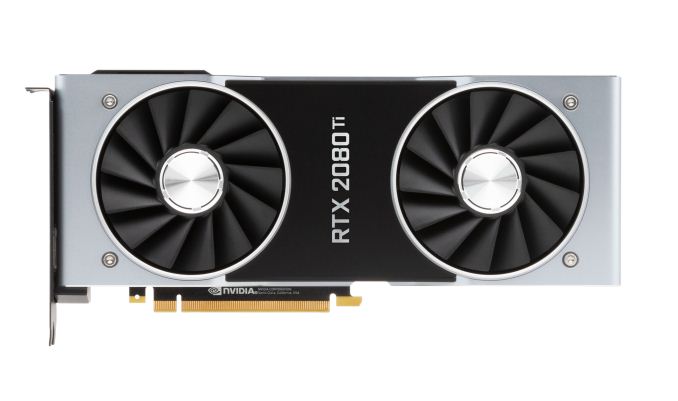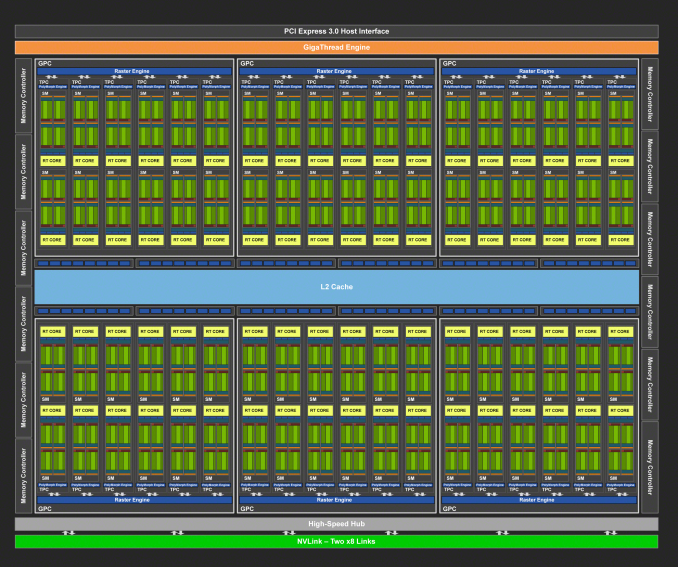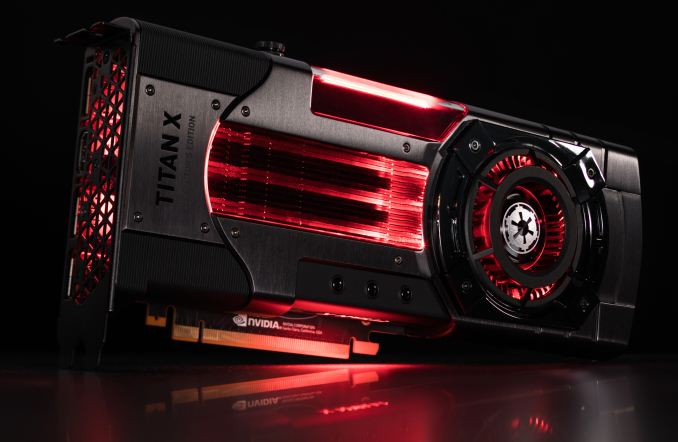The NVIDIA GeForce RTX 2080 Ti & RTX 2080 Founders Edition Review: Foundations For A Ray Traced Future
by Nate Oh on September 19, 2018 5:15 PM EST- Posted in
- GPUs
- Raytrace
- GeForce
- NVIDIA
- DirectX Raytracing
- Turing
- GeForce RTX

While it was roughly 2 years from Maxwell 2 to Pascal, the journey to Turing has felt much longer despite a similar 2 year gap. There’s some truth to the feeling: looking at the past couple years, there’s been basically every other possible development in the GPU space except next-generation gaming video cards, like Intel’s planned return to discrete graphics, NVIDIA’s Volta, and cryptomining-specific cards. Finally, at Gamescom 2018, NVIDIA announced the GeForce RTX 20 series, built on TSMC’s 12nm “FFN” process and powered by the Turing GPU architecture. Launching today with full general availability is just the GeForce RTX 2080, as the GeForce RTX 2080 Ti was delayed a week to the 27th, while the GeForce RTX 2070 is due in October. So up for review today is the GeForce RTX 2080 Ti and GeForce RTX 2080.
But a standard new generation of gaming GPUs this is not. The “GeForce RTX” brand, ousting the long-lived “GeForce GTX” moniker in favor of their announced “RTX technology” for real time ray tracing, aptly underlines NVIDIA’s new vision for the video card future. Like we saw last Friday, Turing and the GeForce RTX 20 series are designed around a set of specialized low-level hardware features and an intertwined ecosystem of supporting software currently in development. The central goal is a long-held dream of computer graphics researchers and engineers alike – real time ray tracing – and NVIDIA is aiming to bring that to gamers with their new cards, and willing to break some traditions on the way.
| NVIDIA GeForce Specification Comparison | ||||||
| RTX 2080 Ti | RTX 2080 | RTX 2070 | GTX 1080 | |||
| CUDA Cores | 4352 | 2944 | 2304 | 2560 | ||
| Core Clock | 1350MHz | 1515MHz | 1410MHz | 1607MHz | ||
| Boost Clock | 1545MHz FE: 1635MHz |
1710MHz FE: 1800MHz |
1620MHz FE: 1710MHz |
1733MHz | ||
| Memory Clock | 14Gbps GDDR6 | 14Gbps GDDR6 | 14Gbps GDDR6 | 10Gbps GDDR5X | ||
| Memory Bus Width | 352-bit | 256-bit | 256-bit | 256-bit | ||
| VRAM | 11GB | 8GB | 8GB | 8GB | ||
| Single Precision Perf. | 13.4 TFLOPs | 10.1 TFLOPs | 7.5 TFLOPs | 8.9 TFLOPs | ||
| Tensor Perf. (INT4) | 430TOPs | 322TOPs | 238TOPs | N/A | ||
| Ray Perf. | 10 GRays/s | 8 GRays/s | 6 GRays/s | N/A | ||
| "RTX-OPS" | 78T | 60T | 45T | N/A | ||
| TDP | 250W FE: 260W |
215W FE: 225W |
175W FE: 185W |
180W | ||
| GPU | TU102 | TU104 | TU106 | GP104 | ||
| Transistor Count | 18.6B | 13.6B | 10.8B | 7.2B | ||
| Architecture | Turing | Turing | Turing | Pascal | ||
| Manufacturing Process | TSMC 12nm "FFN" | TSMC 12nm "FFN" | TSMC 12nm "FFN" | TSMC 16nm | ||
| Launch Date | 09/27/2018 | 09/20/2018 | 10/2018 | 05/27/2016 | ||
| Launch Price | MSRP: $999 Founders $1199 |
MSRP: $699 Founders $799 |
MSRP: $499 Founders $599 |
MSRP: $599 Founders $699 |
||
As we discussed at the announcement, one of the major breaks is that NVIDIA is introducing GeForce RTX as the full upper tier stack with x80 Ti/x80/x70 stack, where it has previously tended towards the x80/x70 products first, and the x80 Ti as a mid-cycle refresh or competitive response. More intriguingly, each GeForce card has their own distinct GPU (TU102, TU104, and TU106), with direct Quadro and now Tesla variants of TU102 and TU104. While we covered the Turing architecture in the preceding article, the takeaway is that each chip is proportionally cut-down, including the specialized RT Cores and Tensor Cores; with clockspeeds roughly the same as Pascal, architectural changes and efficiency enhancements will be largely responsible for performance gains, along with the greater bandwidth of 14Gbps GDDR6.
And as far as we know, Turing technically did not trickle down from a bigger compute chip a la GP100, though at the architectural level it is strikingly similar to Volta/GV100. Die size brings more color to the story, because with TU106 at 454mm2, the smallest of the bunch is frankly humungous for a FinFET die nominally dedicated for a x70 GeForce product, and comparable in size to the 471mm2 GP102 inside the GTX 1080 Ti and Pascal Titans. Even excluding the cost and size of enabled RT Cores and Tensor Cores, a slab of FinFET silicon that large is unlikely to be packaged and priced like the popular $330 GTX 970 and still provide the margins NVIDIA is pursuing.
These observations are not so much to be pedantic, but more so to sketch out GeForce Turing’s positioning in relation to Pascal. Having separate GPUs for each model is the most expensive approach in terms of research and development, testing, validation, extra needed fab tooling/capacity – the list goes on. And it raises interesting questions on the matter of binning, yields, and salvage parts. Though NVIDIA certainly has the spare funds to go this route, there’s surely a better explanation than Turing being primarily designed for a premium-priced consumer product that cannot command the margins of professional parts. These all point to the known Turing GPUs as oriented for lower-volume, and NVIDIA’s financial quarterly reports indicate that GeForce product volume is a significant factor, not just ASP.
And on that note, the ‘reference’ Founders Edition models are no longer reference; the GeForce RTX 2080 Ti, 2080, and 2070 Founders Editions feature 90MHz factory overclocks and 10W higher TDP, and NVIDIA does not plan to productize a reference card themselves. But arguably the biggest change is the move from blower-style coolers with a radial fan to an open air cooler with dual axial fans. The switch in design improves cooling capacity and lowers noise, but with the drawback that the card can no longer guarantee that it can cool itself. Because the open air design re-circulates the hot air back into the chassis, it is ultimately up to the chassis to properly exhaust the heat. In contrast, a blower pushes all the hot air through the back of the card and directly out of the case, regardless of the chassis airflow or case fans.
All-in-all, NVIDIA is keeping the Founders Edition premium, which is now $200 over the baseline ‘reference.’ Though AIB partner cards are also launching today, in practice the Founders Edition pricing is effectively the retail price until the launch rush has subsided.
The GeForce RTX 20 Series Competition: The GeForce GTX 10 Series
In the end, the preceding GeForce GTX 10 series ended up occupying an odd spot in the competitive landscape. After its arrival in mid-2016, only the lower end of the stack had direct competition, due to AMD’s solely mainstream/entry Polaris-based Radeon RX 400 series. AMD’s RX 500 series refresh in April 2017 didn’t fundamentally change that, and it was only until August 2017 that the higher-end Pascal parts had direct competition with their generational equal in RX Vega. But by that time, the GTX 1080 Ti (not to mention the Pascal Titans) was unchallenged. And all the while, an Ethereum-led resurgence of mining cryptocurrency on video cards was wreaking havoc on GPU pricing and inventory, first on Polaris products, then general mainstream parts, and finally affecting any and all GPUs.
Not that NVIDIA sat on their laurels with Vega, releasing the GTX 1070 Ti anyhow. But what was constant was how the pricing models evolved with the Founders Editions schema, the $1200 Titan X (Pascal), and then $700 GTX 1080 Ti and $1200 Titan Xp. Even the $3000 Titan V maintained gaming cred despite diverging greatly from previous Titan cards as firmly on the professional side of prosumer, basically allowing the product to capture both prosumers and price-no-object enthusiasts. Ultimately, these instances coincided with the rampant cryptomining price inflation and was mostly subsumed by it.
So the higher end of gaming video cards has been Pascal competing with itself and moving up the price brackets. For Turing, the GTX 1080 Ti has become the closest competitor. RX Vega performance hasn’t fundamentally changed, and the fallout appears to have snuffed out any Vega 10 parts, as well as Vega 14nm+ (i.e. 12nm) refreshes. As a competitive response, AMD doesn’t have many cards up their sleeves except the ones already played – game bundles (such as the current “Raise the Game” promotion), FreeSync/FreeSync 2, other hardware (CPU, APU, motherboard) bundles. Other than that, there’s a DXR driver in the works and a machine learning 7nm Vega on the horizon, but not much else is known, such as mobile discrete Vega. For AMD graphics cards on shelves right now, RX Vega is still hampered by high prices and low inventory/selection, remnants of cryptomining.
For the GeForce RTX 2080 Ti and 2080, NVIDIA would like to sell you the RTX cards as your next upgrade regardless of what card you may have now, essentially because no other card can do what Turing’s features enable: real time raytracing effects ((and applied deep learning) in games. And because real time ray tracing offers graphical realism beyond what rasterization can muster, it’s not comparable to an older but still performant card. Unfortunately, none of those games have support for Turing’s features today, and may not for some time. Of course, NVIDIA maintains that the cards will provide expected top-tier performance in traditional gaming. Either way, while Founders Editions are fixed at their premium MSRP, custom cards are unsurprisingly listed at those same Founders Edition price points or higher.
| Fall 2018 GPU Pricing Comparison | |||||
| AMD | Price | NVIDIA | |||
| $1199 | GeForce RTX 2080 Ti | ||||
| $799 | GeForce RTX 2080 | ||||
| $709 | GeForce GTX 1080 Ti | ||||
| Radeon RX Vega 64 | $569 | ||||
| Radeon RX Vega 56 | $489 | GeForce GTX 1080 | |||
| $449 | GeForce GTX 1070 Ti | ||||
| $399 | GeForce GTX 1070 | ||||
| Radeon RX 580 (8GB) | $269/$279 | GeForce GTX 1060 6GB (1280 cores) |
|||













337 Comments
View All Comments
Hixbot - Friday, September 21, 2018 - link
I'm not sure how midrange 2070/2060 cards will sell if they're not a significant value in performance/price compared to 1070/1060 cards. If AMD offer no competition, Nvidia should still compete with itselfWwhat - Saturday, September 22, 2018 - link
It's interesting that every comment I've seen says a similar thing and that nobody thinks of uses outside of gaming.I would think that for real raytracers and Adobe's graphics and video software for instance the tensor and RT cores would be very interesting.
I wonder though if open source software will be able to successfully use that new hardware or that Nvidia is too closed for it to get the advantages you might expect.
And apart from raytracers and such there is also the software science students use too.
And with the interest in AI currently by students and developers it might also be an interesting offering.
Although that again relies on Nvidia playing ball a bit.
michaelrw - Wednesday, September 19, 2018 - link
"where paying 43% or 50% more gets you 27-28% more performance"1080 Ti can be bought in the $600 range, wheres the 2080 Ti is $1200 .. so I'd say thats more than 43-50% price increase..at a minimum we're talking a 71% increase, at worst 100% (Launch MSRP for 1080 Ti was $699)
V900 - Wednesday, September 19, 2018 - link
Which is the wrong way of looking at it.NVIDIA didn’t just increase the price for shit and giggles, the Turing GPUs are much more expensive to fab, since you’re talking about almost 20 BILLION transistors squeezed into a few hundred mm2.
Regardless: Comparing the 2080 with the 1080, and claiming there is a 70% price increase, is a bogus logic in the first place, since the 2080 brings a number of things to the table that the 1080 isn’t even capable of.
Find me a 1080ti with DLSS and that is also capable of raytracing, and then we can compare prices and figure out if there’s a price increase or not.
imaheadcase - Wednesday, September 19, 2018 - link
In brings it to the table..on paper more like it. You literally listed the two things that are not really shown AT ALL.mscsniperx - Wednesday, September 19, 2018 - link
No, actually YOUR logic is bogus. Find me a DLSS or Raytracing game to bench.. You can't. There is a reason for that. Raytracing will require a Massive FPS hit, Nvidia knows this and is delaying you from seeing that as damage control.Yojimbo - Wednesday, September 19, 2018 - link
There are no ray tracing games because the technology is new, not because NVIDIA is "delaying them". As far as DLSS, I think those games will appear faster than ray tracing.Andrew LB - Thursday, September 20, 2018 - link
Coming soon:Darksiders III from Gunfire Games / THQ Nordic
Deliver Us The Moon: Fortuna from KeokeN Interactive
Fear The Wolves from Vostok Games / Focus Home Interactive
Hellblade: Senua's Sacrifice from Ninja Theory
KINETIK from Hero Machine Studios
Outpost Zero from Symmetric Games / tinyBuild Games
Overkill's The Walking Dead from Overkill Software / Starbreeze Studios
SCUM from Gamepires / Devolver Digital
Stormdivers from Housemarque
Ark: Survival Evolved from Studio Wildcard
Atomic Heart from Mundfish
Dauntless from Phoenix Labs
Final Fantasy XV: Windows Edition from Square Enix
Fractured Lands from Unbroken Studios
Hitman 2 from IO Interactive / Warner Bros.
Islands of Nyne from Define Human Studios
Justice from NetEase
JX3 from Kingsoft
Mechwarrior 5: Mercenaries from Piranha Games
PlayerUnknown’s Battlegrounds from PUBG Corp.
Remnant: From The Ashes from Arc Games
Serious Sam 4: Planet Badass from Croteam / Devolver Digital
Shadow of the Tomb Raider from Square Enix / Eidos-Montréal / Crystal Dynamics / Nixxes
The Forge Arena from Freezing Raccoon Studios
We Happy Few from Compulsion Games / Gearbox
Funny how the same people who praised AMD for being the first to bring full DX12 support yet only 15 games in the first two years used it, are the same people sh*tting on nVidia for bringing a far more revolutionary technology that's going to be in far more games in a shorter time span.
jordanclock - Thursday, September 20, 2018 - link
Considering AMD was the first to bring support to an API that all GPUs could have support for, DLSS is not a comparison. DLSS is an Nvidia-only feature and Nvidia couldn't manage to have even ONE game on launch day with DLSS.Manch - Thursday, September 20, 2018 - link
AMD spawned Mantle which then turned into Vulcan. Also pushed MS to dev DX12 as it was in both their interests. These APIs can be used by all.DLSS while potentially very cool, is as Jordan said proprietary. Like hair works and other crap ot will get light support but devs when it comes to feature sets will spend most of their effort building to common ground. With consoles being AMD GPU based, guess where that will be.
If will be interesting how AMD will ultimatley respond. Ie gsync/freesync CUDA/OpenCL, etc.
As Nvidia has stated, these features are designed to work with how current game engines already function so they dont (the devs) have to reinvent the wheel. Ultimately this meanz the integration wont be very deep at least not for awhile.
For consumers the end goal is always better graphics at the same price point when new releases happen.
Not that these are bad cards, just expensove and two very key features are unavailable, and that sucks. Hopefully the situation will change sooner rather than later.